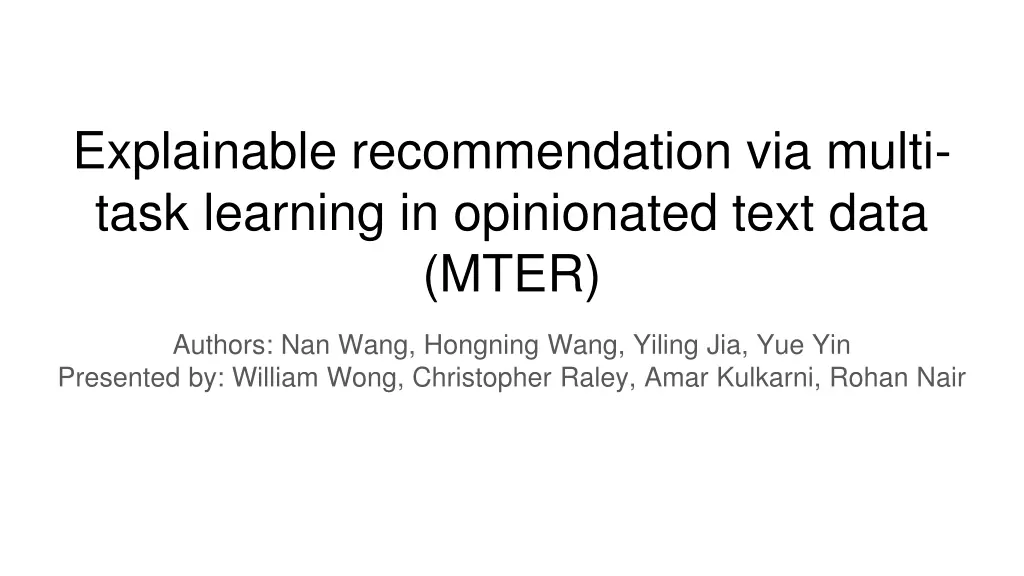
Explainable Recommendation via Multi-Task Learning in Opinionated Text Data
Explore how Multi-Task Learning in opinionated text data can provide explainable recommendations, improving transparency, persuasiveness, and trustworthiness. The proposed solution involves a joint tensor factorization integrating user preference modeling and opinionated content modeling for effective outcomes validated through user studies.
Uploaded on | 0 Views
Download Presentation

Please find below an Image/Link to download the presentation.
The content on the website is provided AS IS for your information and personal use only. It may not be sold, licensed, or shared on other websites without obtaining consent from the author. If you encounter any issues during the download, it is possible that the publisher has removed the file from their server.
You are allowed to download the files provided on this website for personal or commercial use, subject to the condition that they are used lawfully. All files are the property of their respective owners.
The content on the website is provided AS IS for your information and personal use only. It may not be sold, licensed, or shared on other websites without obtaining consent from the author.
E N D
Presentation Transcript
Explainable recommendation via multi- task learning in opinionated text data (MTER) Authors: Nan Wang, Hongning Wang, Yiling Jia, Yue Yin Presented by: William Wong, Christopher Raley, Amar Kulkarni, Rohan Nair
Explainable Recommendations - Help humans understand why items are recommended by algorithm Improves transparency, persuasiveness, effectiveness, trustworthiness, and user satisfaction Allows system designers to better refine recommendation models - -
Proposed Solution? - - Multi-task learning solution for explainable recommendation Two companion learning tasks integrated via joint tensor factorization - User preference modeling - Opinionated content modeling Recommendations + opinionated feature-level textual explanations Effectiveness and practicality verified through user studies - -
Proposed Solution? (cont.) - E2E optimization of performance metrics fails to capture complexity of the decision making process Companion learning tasks target different aspects of user s decision Final assessment can be mutually explained by associated observations Example output generated by MTER: - Amazon Recommendation: Superleggera/Dual/Layer/Protection/case - Explanation: Its grip is [firmer] [soft] [rubbery]. Its quality is [sound] [sturdy] [smooth]. Its cost is [original] [lower] [monthly] - - -
Modeling the Tasks: Item Recommendation - - Constructed from feature-level sentiment analysis of reviews Xijk= to what extent user i appreciates item j s feature k
Modeling the Tasks: Opinionated Content Analysis - - - Two three-way tensors, both from user review content YIijk= Opinionated comments across all users for item j s feature k YUijk= User i s opinionated comments on item j s feature k
Modeling the Tasks - - - Users, items, features, opinionated phrases mapped to shared latent space Item recommendation: project items onto user factor space Explanations: project features and opinionated phrases onto user/item space
Methodology - Preliminaries User s Feature-level opinions Domain-specific sentiment Lexicon Dataset variables and Latent factors m, a - users n, b - items p, c - features q, d - opinionated phrases Domain Specific Lexicon Feature Opinion Sentiment polarity (-1,1) Each users review is mapped to a Lexicon entry
User Preference Modeling Measure user appreciation of item Normalize feature score and overall rating Tucker decomposition for latent factorization Use Bayesian Personalized Ranking in factorization
Opinionated Content Modeling - - Approximate 4-way tensor as 2 3-way tensors to avoid sparsity Only positive phrases are included in each tensor about each feature
Joint Tensor Factorization Multi-Task Explainable Recommendation (MTER) The marriage of high dimensional latent factorization and and 4-way tensor approximation Use mini-batch SGD to solve the optimization problem Gradient of Feature matrix is shared across all three decompositions
Experimentation (Christopher)
Experiment Setup - Evaluate MTER based on two tasks - Personalized item recommendation - Opinionated textual explanations Benchmark against 7 other algorithms - MostPopular (MP) - NMF - BPRMF - JMARS - EFM - MTER-SA - MTER-S Data sets - Amazon (cellphones and accessories) - Yelp (restaurants) - -
Preprocessing - Issue: sparse data sets - Observation: ~15% of features are frequently covered in ~90% of reviews - Rest of the features are rarely covered - Use recursive filtering based on threshold values to obtain more refined datasets
Item Recommendation Results - Evaluation based on Normalized Discounted Cumulative Gain (NDCG) to evaluate top-k recommendations
Opinionated Textual Explanation Results - Evaluate if MTER can predict an actual review s content that a user would be providing for a given item - Features that a user pays attention to in an item - Detailed opinion phrases used to describe an item
Qualitative Analysis of Learnt Factors - To further show the strength of MTER, we can observe a visualization of learnt factors
User Study - - A/B test among the three models: BPR, EFM, MTER (researcher) 900 questionnaire results post-filtering; 150 per model for the Yelp and Amazon datasets. Participants recruited via Amazon MTurk Five questions asked on a 1-5 scale (1 being worst, 5 being best) -
User Study Results - MTER had higher user scores on all questions except Q1/Yelp This clearly demonstrates real users desire in having such detailed explanations of the automatically generated recommendations... our proposed MTER algorithm is a step towards the destination. -
User Study Limitations - User study results are based on qualitative evaluation by the users based on preference Admittedly, this user study is simulation based, and it might be limited by the variance in participants understanding of selected reviews However, difficult to require participants to disclose their review history Privacy concerns -
Conclusion - Researchers Multi-Task Explainable Recommendation (MTER) offers a robust solution to explainable recommendations - Offline experiments and user study indicate effectiveness against leading models Many future routes for research -






















